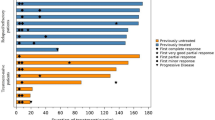Abstract
Recent reports have shown that thalidomide has antiangiogenic activity and is effective for the treatment of refractory multiple myeloma. Unlike other antineoplastic drugs, thalidomide is reported to rarely cause severe hematologic toxicity. In Keio University Hospital, 44 patients with refractory multiple myeloma, including 18 who had relapsed after hematopoietic stem cell transplantation, were treated with this drug as a single agent. Severe grade 3 or 4 neutropenia during thalidomide treatment was observed in 10 patients.This phenomenon was not noted in previous reports. Neutropenia usually occurred in the first or second week of treatment. Concomitant progression of thrombocytopenia occurred in 5 cases, and bone marrow hypoplasia without a significant increase in myeloma cell numbers was also observed in 5 cases. Neutropenia was not correlated with antitumor response or the plasma concentration of thalidomide but was more frequently observed in patients with a low neutrophil and platelet count, anemia, or a high plasma cell percentage in the bone marrow before thalidomide treatment.Thus, this drug should be used carefully for patients with pretreatment cytopenia or a high tumor burden in the bone marrow.
Similar content being viewed by others
References
Tseng S, Pak G, Washenik K, Pomeranz MK, Shupak JL. Rediscovering thalidomide: a review of its mechanism of action, side effects, and potential uses. J Am Acad Dermatol. 1996;35:969–979.
D’Amato RJ, Loughnan MS, Flynn E, Folkman J. Thalidomide is an inhibitor of angiogenesis. Proc Natl Acad Sci U S A. 1994;91: 4082–4085.
Baidas SM, Winer EP, Fleming GF, et al. Phase II evaluation of thalidomide in patients with metastatic breast cancer. J Clin Oncol. 2000;18:2710–2717.
Fine HA, Figg WD, Jaeckle K, et al. Phase II trial of the antiangiogenic agent thalidomide in patients with recurrent high-grade glioma. J Clin Oncol. 2000;18:708–715.
Gutheil J, Finucane D. Thalidomide therapy in refractory solid tumour patients. Br J Haematol. 2000;110:754.
Vacca A, Ribiatti D, Roncali L, et al. Bone marrow angiogenesis and progression in multiple myeloma. Br J Haematol. 1994;87:503–508.
Vacca A, Ribiatti D, Roncali L, Dommacco F. Angiogenesis in B cell lymphoproliferative diseases: biological and clinical studies. Leuk Lymphoma. 1995;20:27–38.
Vacca A, Loreto MD, Ribiatti D, et al. Bone marrow of patients with active myeloma: angiogenesis and plasma cell adhesion molecules LFA-1, VLA-4, LAM-1, and CD44. Am J Hematol. 1995;50:9–14.
Vacca A, Ribiatti D, Presta M, et al. Bone marrow neovascularization, plasma cell angiogenic potential, and matrix metalloproteinase-2 secretion parallel progression of human multiple myeloma. Blood. 1999;93:3064–3073.
Sato N, Hattori Y, Du W, et al. Elevated level of plasma basic fibroblast growth factor in multiple myeloma correlates with increased disease activity. Jpn J Cancer Res. 2002;93:459–466.
Cavenagh JD, Oakervee H. Thalidomide in multiple myeloma: current status and future prospects. Br J Haematol. 2003;120:18–26.
Singhal S, Mehta J. Novel therapies in multiple myeloma. Int J Hematol. 2003;77:226–231.
Larkin M. Low-dose thalidomide seems to be effective in multiple myeloma. Lancet. 1999;354:925.
Singhal S, Mehta J, Desikan R, et al. Antitumor activity of thalidomide in refractory multiple myeloma. N Engl J Med. 1999;341: 1565–1571.
Alexanian R, Weber D. Thalidomide for resistant and relapsing myeloma. Semin Hematol. 2000;37:22–25.
Juliusson G, Celsing F, Turesson I, Lenhoff S, Adriansson M, Malm C. Frequent good partial remissions from thalidomide including best response ever in patients with advanced refractory and relapsed myeloma. Br J Haematol. 2000;109:89–96.
Kneller A, Raanani P, Hardan I, et al. Therapy with thalidomide in refractory multiple myeloma patients: the revival of an old drug. Br J Haematol. 2000;108:391–393.
Barlogie B, Desikan R, Eddlemon P, et al. Extended survival in advanced and refractory multiple myeloma after single-agent thalidomide: identification of prognostic factors in a phase 2 study of 169 patients. Blood. 2001;98:492–494.
Kakimoto T, Hattori Y, Okamoto S, et al. Thalidomide for the treatment of refractory multiple myeloma: association of plasma concentrations of thalidomide and angiogenic growth factors with clinical outcome. Jpn J Cancer Res. 2002;93:1029–1036.
Rajkumar SV, Dispenzieri A, Fonseca R, et al. Thalidomide for previously untreated indolent or smoldering multiple myeloma. Leukemia. 2001;15:1274–1276.
Koc S, Leisenring W, Flowers MED, et al. Thalidomide for treatment of patients with chronic graft-versus-host disease. Blood. 2000;96: 3995–3996.
Parker PM, Chao N, Nademanee A, et al. Thalidomide as salvage therapy for chronic graft-versus-host disease. Blood. 1995;86:3604–3609.
Richardson PG, Schlossman RL, Weller E, et al. Immunomodulatory drug CC-5013 overcomes drug resistance and is well tolerated in patients with relapsed multiple myeloma. Blood. 2002;100: 3063–3067.
Motzer RJ, Berg W, Ginsberg M, et al. Phase II trial of thalidomide for patients with advanced renal cell carcinoma. J Clin Oncol. 2002; 20:302–306.
Munshi N, Desikan KR, Anaissie E, et al. Peripheral blood stem cell collection after CAD+G-CSF as part of total therapy II in newly diagnosed multiple myeloma: influence of thalidomide administration [abstract]. Blood. 1999;94. Abstract 578a.
Author information
Authors and Affiliations
Corresponding author
About this article
Cite this article
Hattori, Y., Kakimoto, T., Okamoto, S. et al. Thalidomide-induced severe neutropenia during treatment of multiple myeloma. Int J Hematol 79, 283–288 (2004). https://doi.org/10.1532/IJH97.03136
Received:
Revised:
Accepted:
Published:
Issue Date:
DOI: https://doi.org/10.1532/IJH97.03136




